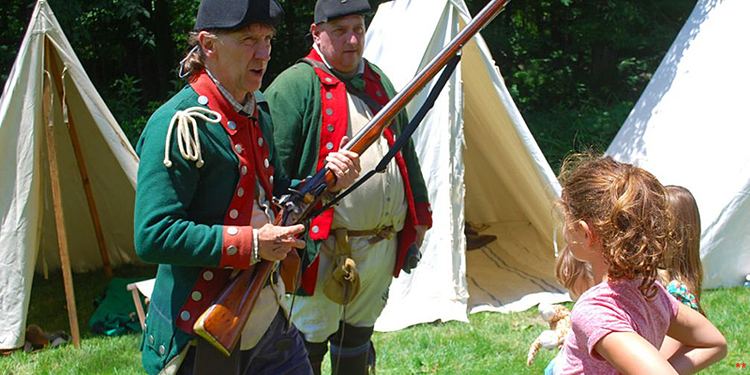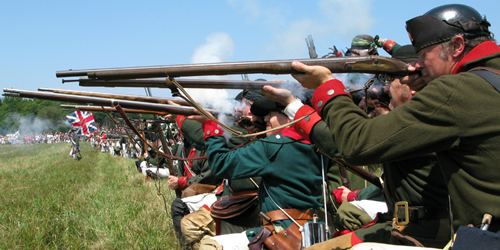Active 1777-1784 Allegiance British Army | Founder John Butler | |
 | ||
Branch British provincial unit Type rangers, (auxiliary troops) Size twelve companies, regiment (800) Similar King's Rangers, Rogers' Rangers, British Legion, New Jersey Volunteers, Fencibles | ||
Butler s rangers
Butler's Rangers (1777–1784) was a Loyalist, British provincial, military unit, during the American Revolutionary War, raised by Loyalist John Butler. Most members, of the regiment, were Loyalists, from upstate New York. Among the Rangers were black former slaves; the total number of black soldiers in Butler's Rangers is unknown, with estimates ranging from two to "more than a dozen". While some blacks served in other Loyalist units and as sappers, in the Engineer Corps and Royal Artillery, Sir William Howe banned the enlistment of blacks, in the British Army and ordered the disbanding of existing black regiments. The Rangers were accused of participating in — or at least failing to prevent — the Wyoming Valley massacre of July 1778 and the Cherry Valley massacre of November 1778 of white settlers (including some Loyalists) by Joseph Brant's Iroquois. These actions earned the Rangers a reputation for exceptional savagery. They fought principally in western New York and Pennsylvania, but ranged as far west as Ohio and Michigan and as far south as Virginia. Their winter quarters were constructed, on the west bank of the Niagara River, in what is now present-day Niagara-on-the-Lake, Ontario. Although, the building, that houses The Lincoln and Welland Regiment Museum, in that community was traditionally known as "Butler's Barracks", it is not the original barracks and never housed Butler's Rangers. It was built, in the years, following the War of 1812, to house the Indian Department and received the name because Butler had been a Deputy Superintendent in that department.
Contents
- Butler s rangers
- Regiment formed
- Campaigns
- Organization
- Uniforms
- Weapons
- Regiment disbanded and resettled in British Canada
- Notable Butlers Rangers
- Novels
- References

Regiment formed

Similar Loyalist regiments, that fought, for the British, during the American Revolution, for example, the King's Royal Regiment of New York or Jessup's Loyal Rangers, Butler's Rangers were made up of American Loyalist refugees, who had fled to Canada, following, the outbreak of, the American Revolution. John Butler was a French and Indian War veteran-turned landowner with a 26,000 acre estate near Caughnawaga in the Mohawk Valley. However, at the outbreak, of American Revolutionary War, Butlter abandoned these landholdings and fled to Canada, in the company of other Revolutionary figures, as Loyalist, Iroquois chief, Joseph Brant. John Butler served, as a deputy to Guy Johnson, himself a loyalist from the Mohawk Valley who led mixed anti-Republican First Nations and loyalist militias.
Campaigns
During the Saratoga Campaign, Lieutenant Colonel Butler distinguished himself at the Battle of Oriskany on August 6, 1777. As a result, he was commissioned a lieutenant colonel and allowed to raise his own British provincial regiment. This military group would come to be known as Butler's Rangers.
Organization
The regimental company commanders of Butler's Rangers, 1777–1784, were:
Uniforms
There is an historical debate, as to what the Butler's Ranger uniform actually looked like. Variation A Their uniforms consisted of a green woolen coat faced white and a white woolen waistcoat. Their pant garment was gaitered trousers made from Russia sheeting, a hemp product. Their hats were round hats, useful in shielding their faces from the sun. When in garrison or on parade, they could bring up the leaves of that hat to form a cocked hat. Their belting was black. Variation B Dark green coats faced with scarlet and lined with the same, a waistcoat of green cloth, and Buckskin Indian leggings reaching from the ankle to the waist...their caps were almost skull caps of black jacket leather or turned up felt with a black cockade on the left side. Their belts were of buff leather and crossed at the breast where they were held in place by a brass plate marked in the same manner and with the same words as the cap plate.
Weapons
They primarily used both the Long-Land and Short-Land forms of the Brown Bess musket. A mix of other firearms may have been used but would have created a supply issue due to calibre variations.
Regiment disbanded and resettled in British Canada
Butler's Rangers were disbanded in June 1784, and its veterans given land grants in the Nassau District, now the Niagara region of Ontario, as a reward for their services to the British crown. In 1788, the Nassau militia was formed with John Butler as its commander, filling its ranks with the demobilized officers and men of Butler's Rangers. In 1792, the Nassau District was changed to the county of Lincoln and the name of the militia changed to Lincoln Militia by 1793. It was the Lincoln Militia who fought in the War of 1812 (1812–1815). This regiment exists today, following a splitting of Lincoln county into the counties of Lincoln and Welland in 1845, as The Lincoln and Welland Regiment, a primary reserve regiment of the Canadian Forces, based out of St. Catharines, Ontario.
